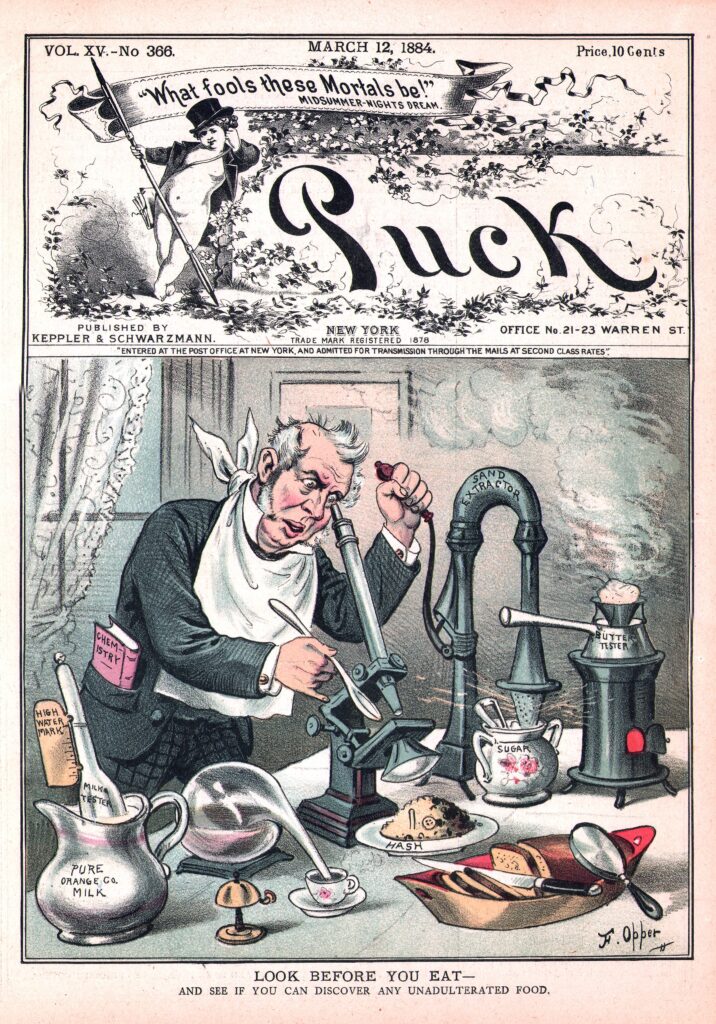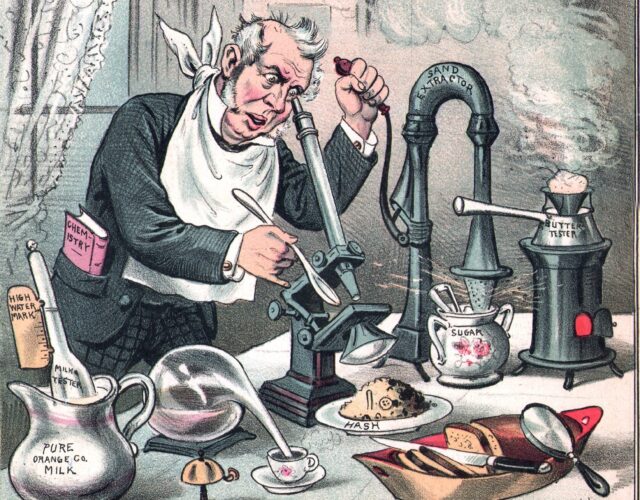The Jungle, Upton Sinclair’s muckraking exposé of industrial meat production, remains well known more than a century after its 1906 publication. Remembered, too, is the first Pure Food and Drug Act passed by Congress that same year.
But American consumers were already worrying about pure food at least 20 years earlier. According to artist Frederick Opper in this 1884 cover cartoon for Puck, a New York magazine of political satire and humor, personal safety seemed to require moving an arsenal of machinery from the laboratory to the dining room.
Why did fear of adulteration rise to the forefront of public consciousness just then? To understand the issue’s urgency we must think about increasing urban population and the distance food traveled to reach larger cities. Mechanical refrigeration had not yet been invented. Chilling food in the 1880s required huge chunks of ice cut from lakes in the winter. Ice blocks were bulky and heavy; they didn’t travel well or last long enough. In the Gilded Age ice could be secured to chill a plutocrat’s oysters but not to preserve most people’s daily food.
Moving fresh food from farm to table was an old problem, but it exploded in importance when burgeoning cities could no longer be fed from homegrown or locally sourced food. For example, New York City, with about 200,000 people, was no village in the 1830s. Yet nearby farm products and fresh-caught fish and seafood were sold in open market stalls. Pigs and chickens ran loose in the streets.
By the time this cartoon appeared New York had become home to more than 1.2 million residents, with another 600,000 inhabitants just across the river in the city of Brooklyn, then the United States’ third largest city. More and more food was needed, and it was arriving from greater distances, even by train. The disconnect between producers and consumers only grew with the emergence of a new middleman sector, one often tempted to adulterate food to hide the deterioration caused by time and distance. Today, milk from nearby Orange County might be chilled and trucked to lower Manhattan in an hour or so; in the 1880s that same distance could take a day or more for an unrefrigerated, horse-drawn wagon.

In the Puck cartoon a milk pitcher holds a lactometer, a specialized form of hydrometer, to measure the density of the liquid. Too low a number would reveal dilution of the farmer’s milk (with chalk or plaster of Paris sometimes added to mask the watery appearance). The alembic (draining into the teacup) was common in popular images of alchemists’ laboratories at that time. The microscope is exaggerated for effect but still easily recognized, as is the chemistry manual in the man’s pocket. If the mechanical device to extract sand from granular sugar seems fanciful, the nearby magnifying glass to find grit and other impurities in bread is not. At the far right the stove-heated “butter tester” reminds readers that oleomargarine, introduced just a few years earlier as a factory-made butter substitute, was a hotly contested product whose ingredients were seen as impure or of dubious origin. “Oleo” was the target of many cartoonists’ jabs before it eventually gained acceptance as simply an alternative spread made from vegetable oil.
Embedded in the cartoonist’s acerbic vision are two unexpected insights about popular consciousness of that time. Many laboratory instruments were recognizable and familiar to ordinary laypeople. And—even more important—science and technology were seen as citizens’ friends, not as mysteriously hidden, potential threats.




